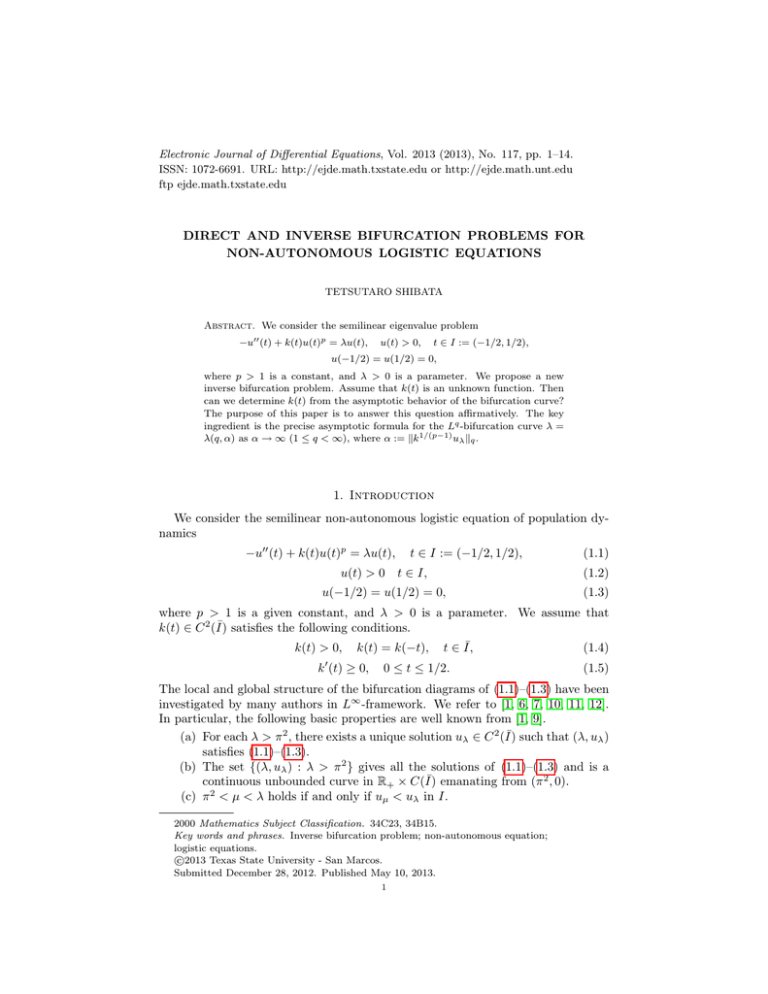Electronic Journal of Differential Equations, Vol. 2013 (2013), No. 117,... ISSN: 1072-6691. URL: or
advertisement

Electronic Journal of Differential Equations, Vol. 2013 (2013), No. 117, pp. 1–14.
ISSN: 1072-6691. URL: http://ejde.math.txstate.edu or http://ejde.math.unt.edu
ftp ejde.math.txstate.edu
DIRECT AND INVERSE BIFURCATION PROBLEMS FOR
NON-AUTONOMOUS LOGISTIC EQUATIONS
TETSUTARO SHIBATA
Abstract. We consider the semilinear eigenvalue problem
−u00 (t) + k(t)u(t)p = λu(t),
u(t) > 0,
t ∈ I := (−1/2, 1/2),
u(−1/2) = u(1/2) = 0,
where p > 1 is a constant, and λ > 0 is a parameter. We propose a new
inverse bifurcation problem. Assume that k(t) is an unknown function. Then
can we determine k(t) from the asymptotic behavior of the bifurcation curve?
The purpose of this paper is to answer this question affirmatively. The key
ingredient is the precise asymptotic formula for the Lq -bifurcation curve λ =
λ(q, α) as α → ∞ (1 ≤ q < ∞), where α := kk1/(p−1) uλ kq .
1. Introduction
We consider the semilinear non-autonomous logistic equation of population dynamics
−u00 (t) + k(t)u(t)p = λu(t),
u(t) > 0
t ∈ I := (−1/2, 1/2),
t ∈ I,
u(−1/2) = u(1/2) = 0,
(1.1)
(1.2)
(1.3)
where p > 1 is a given constant, and λ > 0 is a parameter. We assume that
¯ satisfies the following conditions.
k(t) ∈ C 2 (I)
¯
k(t) > 0, k(t) = k(−t), t ∈ I,
(1.4)
k 0 (t) ≥ 0,
0 ≤ t ≤ 1/2.
(1.5)
The local and global structure of the bifurcation diagrams of (1.1)–(1.3) have been
investigated by many authors in L∞ -framework. We refer to [1, 6, 7, 10, 11, 12].
In particular, the following basic properties are well known from [1, 9].
¯ such that (λ, uλ )
(a) For each λ > π 2 , there exists a unique solution uλ ∈ C 2 (I)
satisfies (1.1)–(1.3).
(b) The set {(λ, uλ ) : λ > π 2 } gives all the solutions of (1.1)–(1.3) and is a
¯ emanating from (π 2 , 0).
continuous unbounded curve in R+ × C(I)
2
(c) π < µ < λ holds if and only if uµ < uλ in I.
2000 Mathematics Subject Classification. 34C23, 34B15.
Key words and phrases. Inverse bifurcation problem; non-autonomous equation;
logistic equations.
c
2013
Texas State University - San Marcos.
Submitted December 28, 2012. Published May 10, 2013.
1
2
T. SHIBATA
EJDE-2013/117
We also emphasize that (1.1)–(1.3) is the model equation of population density
for some species when p = 2. Here, λ and k are regarded as the reciprocal number of
its diffusion rate and the effect of crowd for the species, respectively. Furthermore,
the L1 -norm of the solution represents the total number of the species. From
this biological background, it is significant to study the global structure of the
bifurcation diagram in Lq -framework (1 ≤ q < ∞); we refer to [2, 3, 4, 5, 9, 14,
15, 16, 17]. In this article, we parameterize the solution set as follows. For a given
¯ the solution pair of (1.1)–
α > 0, we denote by (λ(q, α), uα ) ∈ {λ > π 2 } × C 2 (I)
1/(p−1)
(1.3) with kk
uα kq = α, which uniquely exists by (c) above. We call the
graph λ = λ(q, α) (α > 0) the Lq -bifurcation diagram of (1.1)–(1.3). From [1, 9]
we see that
(d) λ(q, α) is increasing for α > 0 and λ(q, α) → ∞ as α → ∞.
From this asymptotic property, we propose a new inverse bifurcation problem
(NIBP) for (1.1)–(1.3), under the following condition on k(t): hypothesis
(H1) Assume that k(t) satisfies (1.4) and (1.5). Furthermore, K 0 (t)/K(t) and
K 00 (t)/K(t) are non-increasing for 0 ≤ t ≤ 1/2, where K(t) := k(t)−1/(p−1) .
Typical examples of k(t) satisfying (H1) are as follows.
k(t) = (1 − t2 )1−p ,
k(t) = kb (t) = cos1−p (bt)
(0 ≤ b < π, with b constant).
Now, the new inverse bifurcation problem is stated as follows.
(NIBP) Assume that the unknown function k(t) satisfies (H1). Let λ0 (q, α) be
the Lq -bifurcation diagram of (1.1)–(1.3) with k(t) ≡ 1. Suppose that as
α → ∞,
λ(q, α) − λ0 (q, α) = o(1).
(1.6)
Then can we determine k(t)?
Inverse problems such as the one above seem to be new for nonlinear problems
and it corresponds to the linear inverse eigenvalue problems, which determine unknown potential from the information about eigenvalues. Therefore, it seems worth
considering.
The main purpose here is to answer the inverse bifurcation problem (NIBP)
affirmatively. To do this, we first consider the direct problem of (1.1)–(1.3), namely,
we establish the precise asymptotic formula for λ(q, α) as α → ∞. Comparing to
the autonomous case, however, there are no works which obtain precise asymptotic
formula in non-autonomous case. We refer to [14, 15, 17]. By the terms which
come from k, k 0 , k 00 and u0 , the tools for autonomous case are not useful any more
in non-autonomous problems.
To overcome this difficulty, we adopt a new parameter kk 1/(p−1) uα kq = α to
parameterize the bifurcation curve λ(q, α). Indeed, in [14, 15], λ(q, α) was parameterized by kuα k2 = α (q = 2) and the calculation there became too complicated,
and the optimal estimate for the third term of λ(q, α) as α → ∞ has not been
obtained there. By the new idea above, the tools for autonomous problems can be
available to our non-autonomous case.
Before stating the results for (NIBP), we first state the result for the direct
problem.
Theorem 1.1. Let p > 1 and q ≥ 1 be fixed constants.
EJDE-2013/117
DIRECT AND INVERSE BIFURCATION PROBLEMS
3
(i) Assume that k is a given function which satisfies (H1). Then, as α → ∞,
λ(q, α) ≥ αp−1 + C1 α(p−1)/2 + a0 + m0 − rp,q + o(1),
λ(q, α) ≤ α
p−1
+ C1 α
(p−1)/2
+ a0 + M0 + o(1),
(1.7)
(1.8)
where
p−1
C(q),
q
Z 1
1 − sq
p
C(q) := 2
ds,
S(s)
0
2
S(s) = 1 − s2 −
(1 − sp+1 ),
p+1
p−1
C(q)2 ,
a0 =
2q
K 00 (t) K 00 (1/2) =
,
M0 = max K(1/2)
0≤t≤1/2 K(t)
K 00 (t) K 00 (0) =
,
m0 = min K(0)
0≤t≤1/2 K(t)
p−1
rp,q =
C2 ,
q
C2 := 4M1 wp,q ,
K 0 (t) K 0 (1/2) =
.
M1 = max K(1/2)
0≤t≤1/2 K(t)
R1p
Z 1
(1 − sq ) s S(η)dη
wp,q :=
ds.
S(s)3/2
0
C1 =
(1.9)
(1.10)
(1.11)
(1.12)
(1.13)
(1.14)
(1.15)
(1.16)
(1.17)
(1.18)
(ii) Let k(t) = kb (t) = cos1−p bt with 0 ≤ b < π. Then, as α → ∞,
λ(q, α) = αp−1 + C1 α(p−1)/2 + a0 + b2 −
b
4(p − 1)
wp,q b tan + o(1).
q
2
(1.19)
As a corollary of Theorem 1.1, we obtain the following result.
Corollary 1.2. Assume that k is a given function satisfying (H1). Then, as α →
∞,
λ(q, α) = αp−1 + C1 α(p−1)/2 + O(1).
(1.20)
From (1.7) and (1.8), we see that the information about k(t) is contained in the
third term of λ(q, α). We also remark that the estimate of the third order in (1.20)
is optimal by (1.7) and (1.8).
To solve (NIBP), we introduce the condition
(H2) k(t) satisfies (H1) and k(0) = 1. Furthermore,
(i) k(t) ≡ 1 on I, or
(ii) If k(t) 6≡ 1, then k(t) satisfies
K 00 (0) 1
,
≤
R1
K(0)
K 0 (1/2) ≤ R2 ,
K(1/2)
where R1 , R2 > 0 are given constants.
(1.21)
4
T. SHIBATA
EJDE-2013/117
The typical examples of k(t) satisfying (H2) are as follows:
k(t) = (1 − t2 )1−p ,
k(t) = kb (t) = cos1−p bt (0 ≤ b < π, with b a constant).
Theorem 1.3. Assume that the unknown function k satisfies (H2). Suppose that
(1.6) holds for a constant q ≥ qp,R ≥ 1, where qp,R is a constant that depends only
on p and R1 , R2 . Then k(t) ≡ 1.
Roughly speaking, if k(t) is nearly flat at t = ±1/2, then qp,R = 1. Now, let
k(t) = kb (t) = cos1−p bt (0 ≤ b < π). Then we have the following simple result.
Theorem 1.4. Let q ≥ 1 be fixed. Further, let k(t) = kb (t) = cos1−p (bt) with
the unknown constant 0 ≤ b 6= bp,q , where 0 < bp,q ≤ π is a constant determined
explicitly by p and q. Assume (1.6) holds with fixed q. Then b = 0, namely,
kb (t) ≡ 1.
Remark 1.5. (i) Assume that k(t) ≡ 1 in Theorem 1.1 (i). Then (1.7) and (1.8)
imply that, as α → ∞,
λ0 (q, α) = αp−1 + C1 α(p−1)/2 + a0 + o(1).
(1.22)
We note that a more precise asymptotic formula for λ0 (q, α) as α → ∞ has been
obtained in [16].
(ii) By (1.6), (1.22) and Theorem 1.1 (ii), we obtain
b 2(p − 1)
b
b
−
wp,q tan
= 0.
(1.23)
b2 − 4wp,q b tan = 2b
2
2
q
2
Therefore, if q/(2(p − 1)) ≤ wp,q , then bp,q = π. For example, let (p, q) = (3, 2).
Then since S(s) = 12 (1 − s2 )2 , by direct calculation, w3,2 = 2(1/2 + log 2)/3 ≥
q/(2(p − 1)) = 1/2. Therefore, b3,2 = π.
If wp,q < q/(2(p − 1)), then there exists a unique constant 0 < bp,q < π such that
b
bp,q /2 = 2(p−1)
wp,q tan p,q
q
2 . So if b 6= bp,q , then (1.6) fails. Therefore, b = 0 if (1.6)
is valid.
(iii) If k(t) = cos1−p bt, then by direct calculation, we obtain M0 = m0 = b2 ,
M1 = b tan(b/2). Then by the same argument as that to obtain Theorem 1.1 (i),
we obtain Theorem 1.1 (ii).
The remainder of this article is organized as follows. In Section 2, we prove
Theorems 1.1 (i) and 1.3 by accepting the key Proposition 2.2 without proof. In
Section 3, we prove Proposition 2.2 by using the tools which are developed in [17].
For completeness, we give the proofs of the basic properties of the solutions in
Section 4 (Appendix).
2. Proof of Theorems 1.1 and 1.3
In what follows, C denotes various positive constants independent of λ 1. We
put vλ (t) := vλ(q,α) (t) = K(t)−1 uα (t). Then by (1.1), we have
K 0 (t) 0
K 00 (t) −vλ00 (t) − 2
vλ (t) + vλ (t)p = λ +
vλ (t), t ∈ I,
(2.1)
K(t)
K(t)
vλ (t) > 0, t ∈ I,
(2.2)
vλ (±1/2) = 0.
(2.3)
EJDE-2013/117
DIRECT AND INVERSE BIFURCATION PROBLEMS
5
We begin with the fundamental properties of vλ . Let Vλ,M0 (t) be the unique solution
of (1.1)–(1.3) with k(t) ≡ 1, and λ replaced by λ − M0 . Then we see that Vm0 (t) ≡
(λ−m0 )1/(p−1) and Vλ,M0 (t) are super-solution and sub-solution of (2.1)–(2.3) with
Vλ,M0 (t) < (λ − m0 )1/(p−1) ,
t ∈ I.
Then by [13],
Vλ,M0 (t) ≤ vλ (t) < (λ − m0 )1/(p−1) .
In particular, from [16] for λ 1, we obtain
(λ − M0 )1/(p−1) − o(1) ≤ kVλ,M0 k∞ ≤ kvλ k∞ < (λ − m0 )1/(p−1) .
(2.4)
(2.5)
By [14], we see that uα (t) is symmetric with respect to t = 0. By this and (1.4),
vλ (t) = vλ (−t)
for t ∈ I.
(2.6)
It is easy to see that
kvλ k∞ = vλ (0).
(2.7)
Further, for 0 ≤ t ≤ 1/2,
vλ0 (t) ≤ 0.
(2.8)
For completeness, the proof of (2.7) and (2.8) will be given in the Appendix. By
[14, Theorem 1.2] and (2.5), as λ → ∞,
vλ (t)
(2.9)
− 1 = O(λ−1 )
kvλ k∞
uniformly on any compact interval in I. Multiply (2.1) by vλ0 (t), we have
00
K 0 (t) 0
K 00 (t) vλ (t) + 2
vλ (t) − vλ (t)p + λ +
vλ (t) vλ0 (t) = 0.
K(t)
K(t)
By (2.7), for 0 ≤ t ≤ 1/2,
Z t
1 0 2
2K 0 (s) 0
1
1
vλ (t) +
vλ (s)2 ds −
vλ (t)p+1 + λvλ (t)2
2
K(s)
p
+
1
2
0
Z t 00
K (s)
+
vλ (s)vλ0 (s)ds = constant
0 K(s)
1
1
= λkvλ k2∞ −
kvλ kp+1
(put t = 0).
∞
2
p+1
This implies
vλ0 (t)2 = Aλ (vλ (t)) + Bλ (t) + Dλ (t).
Here,
2
p+1
Aλ (θ) := λ(kvλ k2∞ − θ2 ) −
(kvλ kp+1
),
∞ −θ
p+1
Z t 0
K (s) 0
Bλ (t) := −4
vλ (s)2 ds ≥ 0,
0 K(s)
Z t 00
K (s)
vλ (s)vλ0 (s)ds ≤ 0
Dλ (t) := −2
0 K(s)
for 0 ≤ 1 ≤ 1/2. Then inequalities (2.13) and (2.14) follow from (H1).
Let µ := λ − m0 . By (1.4), (2.8), (2.10) and (2.14), for 0 ≤ t ≤ 1/2,
q
p
− vλ0 (t) = Aλ (vλ (t)) + Bλ (t) + Dλ (t) ≤ A0,λ (vλ (t)) + Bλ (t),
(2.10)
(2.11)
(2.12)
(2.13)
(2.14)
(2.15)
6
T. SHIBATA
EJDE-2013/117
where
2
p+1
(kvλ kp+1
).
(2.16)
∞ −θ
p+1
We know that A0,λ (θ) > 0 for 0 ≤ θ < kvλ k∞ . Therefore, A0,λ (vλ (t)) + Bλ (t) > 0
for 0 < t ≤ 1/2. By (2.15),
A0,λ (θ) := µ(kvλ k2∞ − θ2 ) −
kvλ kq∞ − kvλ kqq
Z 1/2
(kvλ kq∞ − vλ (t)q ) p
=2
0
Z
1/2
(kvλ kq∞ − vλ (t)q ) p
≥2
0
−vλ0 (t)
Aλ (vλ (t)) + Bλ (t) + Dλ (t)
dt
−vλ0 (t)
dt
A0,λ (vλ (t)) + Bλ (t)
1/2
−vλ0 (t)
− vλ (t) ) p
dt
=2
A0,λ (vλ (t))
0
Z 1/2
v 0 (t)
−vλ0 (t)
+2
+p λ
dt
(kvλ kq∞ − vλ (t)q ) p
A0,λ (vλ (t)) + B(t)
A0,λ (vλ (t))
0
:= I + II.
Z
(kvλ kq∞
(2.17)
q
We put
2 kvλ kp−1
∞
Rλ (s) := 1 − s2 −
(1 − sp+1 ),
p+1
µ
Z 1
(1 − sq )(S(s) − Rλ (s))
p
p
p
p
Uλ := 2
ds.
Rλ (s) S(s)( Rλ (s) + S(s))
0
(2.18)
(2.19)
Lemma 2.1. For λ 1,
I=
kvλ kq∞
(C(q) + Uλ ) ,
√
µ
|Uλ | ≤ Cλ−1 log λ.
(2.20)
(2.21)
The proof of the above lemma is the variant of [16, Lemmas 3.1 and 3.2]. For
completeness, it will be given in Appendix.
Proposition 2.2. For λ 1, the integral II defined by (2.17) satisfies
q+1−p
II = −C2 kvλ k∞
(1 + o(1)).
(2.22)
The proof of this proposition will be given in Section 3. Meanwhile, we use for
proving Theorem 1.1.
Proof of Theorem 1.1. We first prove (1.8). By (1.22) and (2.4), for λ 1, we
obtain
λ − M0 = kVλ,M0 kqp−1 + C1 kVλ,M0 kq(p−1)/2 + a0 + o(1)
≤ kvλ kqp−1 + C1 kvλ k(p−1)/2
+ a0 + o(1).
q
Therefore, we obtain (1.8).
Next we show (1.7). By (2.5) and (2.21), we see that for λ 1,
(1−p)/2
|Uλ | ≤ Cλ−1 log λ = o(kvλ k∞
).
(2.23)
EJDE-2013/117
DIRECT AND INVERSE BIFURCATION PROBLEMS
7
By (2.17), (2.23), Lemma 2.1 and Proposition 2.2, we obtain
kvλ kq∞ − kvλ kqq ≥
kvλ kq∞
(1 + o(1))).
√ (C(q) − C2 kvλ k(1−p)/2
∞
µ
(2.24)
That is,
1
kvλ kq∞ 1 − √ (C(q) − C2 kvλ k(1−p)/2
(1 + o(1))) ≥ αq .
∞
µ
(2.25)
By this inequality, (1.8), (2.5) and the Taylor expansion, we obtain
µ = λ − m0 ≥ kvλ kp−1
∞
−(p−1)/q
1
(1−p)/2
≥ αp−1 1 − √ (C(q) − C2 kvλ k∞
(1 + o(1)))
µ
1 p−1
C(q)(1 + o(1))
= αp−1 1 + √
µ q
p
−
1
= αp−1 +
C(q)α(p−1)/2 + o(α(p−1)/2 ).
q
By this equality and (1.8), for α 1, we have
µ = αp−1 + C1 α(p−1)/2 + o(α(p−1)/2 ).
(2.26)
By (2.5), (2.25) and the Taylor expansion, for λ 1, we have
λ − m0 ≥ kvλ kp−1
∞
−(p−1)/q
1
≥ αp−1 1 − √ (C(q) − C2 kvλ k(1−p)/2
(1 + o(1)))
∞
µ
n
p
−
1
1
≥ αp−1 1 +
(p−1)/2
(1−p)/2
q α
(1 + C1 α
+ o(α(1−p)/2 ))1/2
× (C(q) − C2 α(1−p)/2 + o(α(1−p)/2 ))
+
(p − 1)(p + q − 1)
1
2q 2
αp−1 (1 + C1 α(1−p)/2 + o(α(1−p)/2 ))
× (C(q) − C2 (1 + o(1))α(1−p)/2 + o(α(1−p)/2 ))2 (1 + o(1))
= αp−1 +
o
p − 1 (p−1)/2
1
α
(1 − C1 α(1−p)/2 + o(α(1−p)/2 ))
q
2
× (C(q) − C2 α(1−p)/2 + o(α(1−p)/2 ))
+
(p − 1)(p + q − 1)
(C(q)2 − C1 C(q)2 α(1−p)/2
2q 2
− 2C(q)C2 α(1−p)/2 + o(α(1−p)/2 ))
= αp−1 +
−
p−1
p−1
(p − 1)(p + q − 1)
C(q)α(p−1)/2 −
C1 C(q) +
C(q)2
q
2q
2q 2
p−1
C2 + o(1)
q
= αp−1 + C1 α(p−1)/2 + a0 −
p−1
C2 + o(1).
q
Thus we obtain (1.7). The proof of Theorem 1.1 is complete.
8
T. SHIBATA
EJDE-2013/117
Proof of Theorem 1.3. By (1.6) and (1.7), we have
m0 ≤ rp,q .
(2.27)
We assume that (H2) (ii) is valid, and obtain a contradiction. Since rp,q = 4(p −
1)wp,q M1 /q, for 0 < 1, by (1.21) and (2.27), we have
1
m0
4(p − 1)
≤
≤
wp,q
R1 R2
M1
q
R1p
Z
4(p − 1) 1− (1 − sq ) s S(η)dη
=
ds
q
S(s)3/2
0
R1p
Z
4(p − 1) 1 (1 − sq ) s S(η)dη
+
ds
q
S(s)3/2
1−
:= L1 + L2 .
(2.28)
We have to consider only the case where q 1. If q 1, then we have
L1 ≤
C
1.
q
(2.29)
Furthermore, for 1 − ≤ η ≤ 1 and 0 < δ 1, by Taylor expansion,
Sλ (η) ≤ (p − 1)(1 − η)2 ,
(2.30)
2
Sλ (η) ≥ (p − 1 − δ)(1 − η) .
(2.31)
By (2.30) and (2.31), for q 1,
R1
Z
Z
C 1 (1 − sq ) s (1 − η)dη
C 1 1 − sq
L2 ≤
ds
≤
ds ≤ Cq −1 log q 1. (2.32)
q 1−
(1 − s)3
q 1− 1 − s
This inequality and (2.29) contradict (2.28). Therefore, (H2) (i) holds. Thus the
proof is complete.
3. Proof of Proposition 2.2
Let an arbitrary 0 < 1 be fixed. The integral II defined by (2.17) satisfies
Z 1/2
Bλ (t)vλ0 (t)
II = 2
(kvλ kq∞ − vλ (t)q ) p
A0,λ (vλ (t)) + Bλ (t)
0
1
p
p
dt
×p
(3.1)
A0,λ (vλ (t)) A0,λ (vλ (t)) + Bλ (t) + A0,λ (vλ (t))
Z 1/2− Z 1/2 =2
+
:= II1 + II2 .
0
1/2−
Lemma 3.1. For 0 ≤ t ≤ 1/2,
(p+1)/2
Bλ (t) ≤ Ckvλ k∞
(kvλ k∞ − vλ (t)).
(3.2)
Proof. There exists 0 ≤ tλ ≤ 1/2 such that max0≤t≤1/2 |vλ0 (t)| = |vλ0 (tλ )|. We first
show that
vλ0 (tλ )2
≤ C.
(3.3)
kvλ kp+1
∞
EJDE-2013/117
DIRECT AND INVERSE BIFURCATION PROBLEMS
9
To prove this, we assume that there exists a subsequence of {λ}, which is denoted
by {λ} again, such that, as λ → ∞,
vλ0 (tλ )2
→∞
kvλ kp+1
∞
(3.4)
and derive a contradiction. Since
Z
Z
t K 00 (s)
t
vλ (s)vλ0 (s)ds
vλ (s)vλ0 (s)ds ≤ C 0 K(s)
0
=
C(kvλ k2∞
(3.5)
2
Ckvλ k2∞ ,
− vλ (t) ) ≤
by putting t = tλ in (2.10), we obtain from (3.4) and (3.5) that
Z tλ 0
1
K (s) 0
0
2
(1 − o(1))vλ (tλ ) = −2
v (s)2 ds
2
K(s) λ
0
Z tλ
≤ C|vλ0 (tλ )|
−vλ0 (s)ds
0
≤ C|vλ0 (tλ )|kvλ k∞ .
This inequality implies |vλ0 (tλ )| ≤ Ckvλ k∞ , which contradicts (3.4). Therefore, we
obtain (3.3). Then by (2.8), (2.13) and (3.3), for 0 ≤ t ≤ 1,
Z t
Bλ (t) ≤ C
vλ0 (s)2 ds
0
≤
≤
C|vλ0 (tλ )|
Z
1/2
(−vλ0 (s))ds
0
(p+1)/2
Ckvλ k∞
(kvλ k∞ − vλ (t)).
Thus the proof is complete.
Lemma 3.2. For 0 ≤ t ≤ 1/2,
3/2
Bλ (t) ≤ Ckvλ kp/2
.
∞ (kvλ k∞ − vλ (t))
(3.6)
Proof. Recall that B(t) is increasing for 0 ≤ t ≤ 1/2 by (H1) and (2.13). By (2.5),
(2.13), (2.15) and Lemma 3.1,
Z t 0 q
K (s)
A0,λ (vλ (s)) + Bλ (s)(−vλ0 (s))ds
Bλ (t) = −4
0 K(s)
Z t q
p
≤ 4M1
A0,λ (vλ (s)) + Bλ (s) (−vλ0 (s))ds
0
Z
kvλ k∞
≤ 4M1
q
A0,λ (θ)dθ + 4M1 max
0≤s≤t
vλ (t)
√
≤ C µkvλ k2∞
√
= C µkvλ k2∞
Z
p
Z
Bλ (s)
t
(−vλ0 (s))ds
0
1
vλ (t)/kvλ k∞
1
Z
p
p
Rλ (s)ds + C Bλ (t)(kvλ k∞ − vλ (t)).
p
p
1 − s2 ds + C Bλ (t)(kvλ k∞ − vλ (t))
vλ (t)/kvλ k∞
vλ (t) 3/2
√
≤ C µkvλ k2∞ 1 −
+ Ckvλ k(p+1)/4
(kvλ k∞ − vλ (t))3/2
∞
kvλ k∞
3/2
≤ Ckvλ kp/2
.
∞ (kvλ k∞ − vλ (t))
10
T. SHIBATA
EJDE-2013/117
Thus the proof is complete.
Lemma 3.3. For λ 1,
q+1−p
II1 = o(kvλ k∞
).
(3.7)
Proof. By (2.9), (2.31), (3.1), Lemma 3.2 and putting s = vλ (t)/kvλ k∞ , for λ 1,
we have
Z 1/2−
(kvλ kq∞ − vλ (t)q )Bλ (t)(−vλ0 (t))
dt
|II1 | ≤ C
2(A0,λ (vλ (t))3/2
0
Z 1
(p+3)/2
q
kvλ kq+1
(1 − s)3/2
∞ · (1 − s )kvλ k∞
≤C
ds
3/2
3
3/2
µ kvλ k∞ Sλ (s)
vλ (1/2−)/kvλ k∞
Z 1
q+1−p
(1 − s)−1/2 ds
≤ Ckvλ k∞
vλ (1/2−)/kvλ k∞
=
q+1−p
Ckvλ k∞
vλ (1/2 − )
1−
kvλ k∞
1/2
q+1−p
= o(kvλ k∞
).
Thus the proof is complete.
Now we estimate II2 .
Lemma 3.4. For λ 1,
q+1−p
− II2 ≤ C2 (1 + o(1))kvλ k∞
.
(3.8)
Proof. Let 1/2 − ≤ t ≤ 1/2. Then by (1.17), (2.15), Lemmas 3.1 and 3.2,
Z t
Z t 0
K (s) 0
Bλ (t) = −4
vλ (s)2 ds ≤ 4M1
vλ0 (s)2 ds
0 K(s)
0
Z t q
p
≤ 4M1
( A0,λ (vλ (s) + Bλ (s))(−vλ0 (s))ds
0
√
≤ 4M1 µkvλ k2∞
Z
+ Ckvλ k(p+1)/4
∞
1
p
Rλ (s)ds
vλ (t)/kvλ k∞
Z t
(kvλ k∞ − vλ (s))1/2 (−vλ0 (s))ds
0
√
≤ 4M1 (1 + o(1)) µkvλ k2∞
Z 1
p
×
Sλ (s)ds + Ckvλ k(p+1)/4
(kvλ k∞ − vλ (t))3/2 .
∞
vλ (t)/kvλ k∞
By this inequality, (2.9) and (3.1), we have
√
−II2 ≤ 4M1 (1 + o(1)) µkvλ k2∞
p
R1
Z 1/2
Sλ (η)dη
v
(t)/kv
k
λ ∞
×
(kvλ kq∞ − vλ (t)q ) λ
(−vλ0 (t))dt
A0,λ (vλ (t))3/2
1/2−
Z 1/2
(kvλ kq∞ − vλ (t)q )(kvλ k∞ − vλ (t))3/2
(p+1)/4
(−vλ0 (t))dt
+ Ckvλ k∞
3/2
A
(v
(t))
0,λ λ
1/2−
R1p
Z vλ (1/2−)/kvλ k∞
(1 − sq ) s Sλ (η)dη
q+1−p
= 4M1 (1 + o(1))kvλ k∞
ds
Sλ (s)3/2
0
EJDE-2013/117
+
DIRECT AND INVERSE BIFURCATION PROBLEMS
q+1−p+(1−p)/4
Ckvλ k∞
vλ (1/2−)/kvλ k∞
Z
0
11
(1 − sq )(1 − s)3/2
ds
Sλ (s)3/2
= C2 (1 + o(1))kvλ kq+1−p
.
∞
Thus the proof is complete.
Lemma 3.5. Let an arbitrary 0 < δ 1 be fixed. Then for λ 1,
q+1−p
− II2 ≥ C2 (1 − C)kvλ k∞
.
(3.9)
Proof. By (2.15), we have
p
p
p
p
−vλ0 (t) = Aλ (vλ (t)) + Bλ (t) + Dλ (t) ≥ Aλ (vλ (t)) − Bλ (t) − |Dλ (t)|.
(3.10)
Let 1/2 − < t < 1/2. Since is small enough, by (1.17) and (3.10), we have
Z t
Z t
K 0 (s) 0
2
vλ0 (s)2 ds
vλ (s) ds ≥ 4(M1 − δ)
Bλ (t) ≥ −4
1/2−
1/2− K(s)
Z t
p
≥ 4(M1 − 2δ)
Aλ (vλ (s))(−vλ0 (s))ds
(3.11)
1/2−
Z
t
−C
p
Bλ (s)(−vλ0 (s))ds
Z
t
−C
1/2−
p
|Dλ (s)|(−vλ0 (s))ds.
1/2−
By (2.14), we obtain
Z t
Z
p
|Dλ (s)|(−vλ0 (s))ds ≤ C
1/2−
t
kvλ k2∞ − vλ (t)2
1/2
(−vλ0 (s))ds
1/2−
Z
vλ (1/2−)
(kvλ k2∞ − θ2 )1/2 dθ
≤C
vλ (t)
≤ Ckvλ k2∞
Z
(3.12)
1
(1 − s2 )1/2 ds
vλ (t)/kvλ k∞
3/2
≤ Ckvλ k1/2
.
∞ (kvλ k∞ − vλ (t))
Then by (3.11), (3.12), Lemma 3.2 and the same argument as the one to obtain
(2.21) and Lemma 3.4, we obtain (3.9). Thus the proof is complete.
Since 0 < δ 1 is arbitrary, by Lemmas 3.4 and 3.5, we have competed the
proof of Proposition 2.2.
4. Appendix
Proof of (2.7). We assume that kvλ k∞ > vλ (0) and derive a contradiction. First,
suppose that vλ00 (0) ≥ 0. Let 0 < tλ < 1/2 satisfy vλ (tλ ) = kvλ k∞ . Then by (2.1)
and (2.5),
K 00 (0)
− vλ (0)p−1 = vλ (0)(λ − m0 − vλ (0)p−1 ) > 0.
0 ≥ −vλ00 (0) = vλ (0) λ +
K(0)
This is a contradiction. Next, suppose that vλ00 (0) < 0. Then there exists 0 <
sλ < tλ < 1/2 such that vλ0 (sλ ) = 0 and vλ00 (sλ ) ≥ 0. By this and the fact that
vλ (sλ ) < vλ (tλ ) = kvλ k∞ , and (2.1), we have
K 00 (sλ ) 0 ≥ −vλ00 (sλ ) = −vλ (sλ )p−1 + λ +
vλ (sλ ),
K(sλ )
12
T. SHIBATA
EJDE-2013/117
K 00 (tλ ) 0 ≤ −vλ00 (tλ ) = −vλ (tλ )p−1 + λ +
vλ (tλ ).
K(tλ )
This implies
λ+
K 00 (sλ ) K 00 (tλ ) ≤ vλ (sλ )p−1 < vλ (tλ )p−1 ≤ λ +
.
K(sλ )
K(tλ )
This contradicts to (H1). Thus we obtain (2.7).
(4.1)
Proof of (2.8). By (2.7), we see that there exists a constant 0 < t0 ≤ 1/2 such that
t0 := sup{s : 0 ≤ s ≤ 1 and vλ0 (t) ≤ 0 for any 0 ≤ t ≤ s}.
(4.2)
If t0 = 1/2, then the proof is complete. Assume that t0 < 1/2. Then vλ0 (t0 ) = 0.
Assume that there exists a constant 0 < t0 < s0 < 1/2 such that vλ (t0 ) < vλ (s0 ).
Then there exists t0 ≤ t1 < s1 < 1/2 such that vλ (t1 ) < vλ (s1 ) and vλ0 (t1 ) =
0, vλ00 (t1 ) ≥ 0 and vλ0 (s1 ) = 0, vλ00 (s1 ) ≤ 0 Then by the same argument as the proof
of (2.7) above, we obtain a contradiction. Therefore, vλ (t) is non-increasing for
t0 ≤ t ≤ 1/2. Thus the proof of (2.8) is complete.
Proof of Proposition 2.2. We apply the same argument as that in [16, Lemma 3.2]
to our situation. For λ > π 2 and 0 ≤ s ≤ 1, we put
2
p+1
(kvλ kp+1
),
∞ −θ
p+1
2
p+1
Qλ (s) := µkvλ k2∞ (1 − s2 ) −
kvλ kp+1
).
∞ (1 − s
p+1
Mλ (θ) := µ(kvλ k2∞ − θ2 ) −
By putting θ = uλ (t) and s = θ/kuλ k∞ , we obtain
Z 1
−vλ0 (t)
I=2
(kvλ kq∞ − vλq (t)) p
dt
A0,λ (vλ (t))
0
Z kvλ k∞
1
dθ
=2
(kvλ kq∞ − θq ) p
Mλ (θ)
0
Z
kvλ kq∞ 1
1 − sq
p
=2 √
ds
µ
Qλ (s)/(µkvλ k2∞ )
0
Z 1
kvλ kq
1 − sq
p
=2 √ ∞
ds
µ
Rλ (s)
0
Z 1
kvλ kq 1 − sq
p
= √ ∞ 2
ds + Uλ
µ
Sλ (s)
0
q
kvλ k
= √ ∞ C(q) + Uλ .
µ
By (2.5), for λ 1, we have
p−1
ξλ := λ − kvλ k∞
= O(1).
(4.3)
Let 0 < 1 be fixed. Then by Taylor expansion, there exists a constant 0 < δ 1
such that for λ 1 and 1 − ≤ s ≤ 1
Rλ (s) ≥
ξλ
(1 − s) + (p − 1 − δ)(1 − s)2 .
λ
(4.4)
EJDE-2013/117
DIRECT AND INVERSE BIFURCATION PROBLEMS
13
By (2.19),
Uλ = U1,λ + U2,λ
Z 1−
(1 − sq )(Sλ (s) − Rλ (s))
p
p
p
p
ds
:= 2
Rλ (s) Sλ (s)( Rλ (s) + Sλ (s))
0
Z 1
(1 − sq )(Sλ (s) − Rλ (s))
p
p
p
p
+2
ds.
Rλ (s) Sλ (s)( Rλ (s) + Sλ (s))
1−
By (2.18), (2.31) and (4.4), we have
Z 1
p−1
(1 − sq )(1 − sp+1 )(1 − kvλ |∞
/λ)
p
|U2,λ | ≤ 2
ds
Rλ (s) Sλ (s)
1−
Z
ξλ 1
1
≤C
ds
λ 1− (ξλ /λ) + (p − 1 − δ)(1 − s)
Z ξλ
1
dη
=C
λ 0 (ξλ /λ) + Cη
ξλ ξλ ≤ C log
λ
λ
≤ Cλ−1 log λ.
(4.5)
(4.6)
Finally, it is clear that Sλ (s) ≥ C, Rλ (s) ≥ C for 0 ≤ s ≤ 1 − and λ 1. By
(4.3) and (4.5),
Z 1−
ξλ
p−1
|U1,λ | ≤ C
(1 − sq )(1 − sp+1 )(1 − kvλ |∞
/λ)ds ≤ C
≤ Cλ−1 .
λ
0
By (4.5) and (4.6), we obtain Proposition 2.2. Thus the proof is complete.
References
[1] H. Berestycki; Le nombre de solutions de certains problèmes semi-linéares elliptiques, J.
Funct. Anal., 40 (1981), 1–29.
[2] J. Chabrowski; On nonlinear eigenvalue problems, Forum Math., 4 (1992), 359–375.
[3] R. Chiappinelli; Remarks on bifurcation for elliptic operators with odd nonlinearity; Israel J.
Math. 65 (1989), 285–292.
[4] R. Chiappinelli; On spectral asymptotics and bifurcation for elliptic operators with odd superlinear term, Nonlin. Anal., 13 (1989), 871–878.
[5] R. Chiappinelli; Constrained critical points and eigenvalue approximation for semilinear
elliptic operators, Forum Math., 11 (1999), 459–481.
[6] J. M. Fraile, J. López-Gómez, J. Sabina de Lis; On the global structure of the set of positive
solutions of some semilinear elliptic boundary value problems, J. Differential Equations, 123
(1995), 180–212.
[7] J. Garcı́a-Melián, J. Sabina de Lis; Stationary profiles of degenerate problems when a parameter is large, Differential Integral Equations, 13 (2000), 1201–1232.
[8] B. Gidas, W. M. Ni, L. Nirenberg; Symmetry and related properties via the maximum principle, Comm. Math. Phys., 68 (1979), 209–243.
[9] H.-P. Heinz; Nodal properties and variational characterizations of solutions to nonlinear
Sturm-Liouville problems, J. Differential Equations, 62 (1986), 299–333.
[10] M. Holzmann, H. Kielhöfer; Uniqueness of global positive solution branches of nonlinear
elliptic problems, Math. Ann., 300 (1994), 221–241.
[11] P. Rabinowitz; A note on a nonlinear eigenvalue problem for a class of differential equations,
J. Differential Equations, 9 (1971), 536–548.
[12] P. Rabinowitz; Some global results for nonlinear eigenvalue problems, J. Funct. Anal., 7
(1971), 487–513.
14
T. SHIBATA
EJDE-2013/117
[13] J. Schoenenberger-Deuel, P. Hess; A criterion for the existence of solutions of non-linear
elliptic boundary value problems, Proc. Roy. Soc. Edinburgh Sect. A, 74 (1974/75), 49–54
(1976).
[14] T. Shibata; Asymptotic formulas of eigenvalues and eigenfunctions of non-autonomous semilinear Sturm-Liouville problems, Math. Z., 219 (1995), 485-498.
[15] T. Shibata; Precise spectral asymptotics for nonautonomous logistic equations of population
dynamics in a ball, Abst. Applied Anal., 2005:6 (2005) 563–573.
[16] T. Shibata; Global behavior of the branch of positive solutions to a logistic equation of population dynamics, Proc. Amer. Math. Soc., 136 (2008), 2547–2554.
[17] T. Shibata; Spectral asymptotics for inverse nonlinear Sturm-Liouville problems, Electron.
J. Qual. Theory Differ. Equ., 2009 No. 58, 18 pp.
Tetsutaro Shibata
Laboratory of Mathematics, Institute of Engineering, Hiroshima University, HigashiHiroshima, 739-8527, Japan
E-mail address: shibata@amath.hiroshima-u.ac.jp





